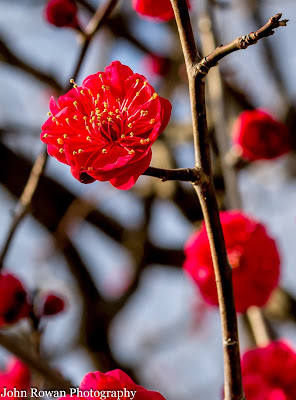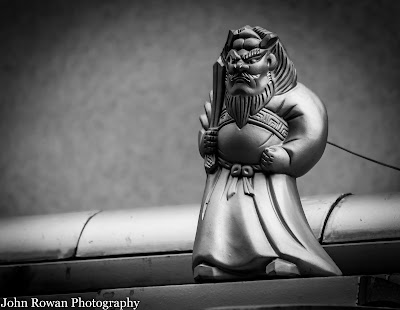It is two days away from Imbolc and here in Kyoto something is stirring. This morning the winter light's harshness seemed to be softening; one of the first signs of spring. I had a lot to do today, but somehow I new I had to make time to visit an old friend in the afternoon. This old friend is an Ume tree (plum). If trees have astrological signs, this one is an Aries. It is about two weeks away from when most Ume will start to bloom and about four weeks away from full blossom. But from past experience I knew this one does not have the patience to wait and by Imbolc beautiful red flowers are starting to bloom. I was not disappointed.
Sunday 31 January 2016
Thursday 21 January 2016
Tiny Statues on the Roof
On many of the traditional houses in Kyoto you find tiny statues. They are there to protect the house from evil spirits, the are a kind of amulet or in Japanese mayoke 魔除け. I believe they are depictions of Enmadaiou 閻魔大王、who is a judge in Meido 冥土,the kingdom of the awaiting dead. Those that he judges to be evil are sent to Jigoku 地獄, Hell. Basically the statues are reflecting evil spirits away from the house. But that can mean in Kyoto's traditional narrow streets, that you are sending the spirits to the house across the street. So it is not uncommon to see two of these statues facing each other.
Sunday 10 January 2016
Mysterious Tarot
Yesterday, I was walking through the back streets of Kyoto taking pictures, when I came across a fortune teller's shop. This is not so unusual there are many fortune tellers in Kyoto, but I found the sign to be intriguing. "Witches" written in English, first caught my eye, but it was the Japanese that caught my interest. I could not read the first two characters together, but I knew them. The first is kami, god and the second I recognised but could not remember. The remaining Japanese was easy to read, no meaning belonging to, and Tarot. So I took a picture of the sign to check later.
Today I remembered the sign and decided to check. The word is shinpi , meaning mystery or more precisely the mysteries. So I translate it as "The Tarot of the Mysteries". Which started me thinking about how mysterious the Tarot is. The Japanese word shinpi is generally used for example in: the mysteries of the sea, the mysteries of the universe. So what kind of mystery is the Tarot a part of? For me, the Tarot belongs to the mysteries of symbols. Along with runes, dreams and so on, it communicates to our subconscious through images. This brought me back to the fortune tellers sign: obviously I could read the English word witches and to some extent the Japanese too, but was something symbolic happening as well?
There is a crescent moon on the sign and a pentagram embedded in to the katakana character タ. So I believe that if the word witches was replaced by the Japanese word 魔女, still a non-Japanese reading: tarot reader, wiccan, pagan or so on would be drawn to the sign and gain some meaning from it.
The biggest mystery for me is how symbolically the Tarot consistently creates the story to be told. We say to read the Tarot, but that has a nuance of interpretation, but I feel it is more like narration. I remember when I first started to read the Tarot, I was young and somewhat shy, but the words flowed effortlessly when I gave readings. Now when I give readings in Japanese, I am much more fluent than at other times. The symbolism of the Tarot flows through me.
It is the time of the new moon in Capricorn, while walking back from a shrine dedicated to my chosen god Ebisu, I instinctively took a road I had never taken before and found this fortune teller's shop. Is there any symbolic meaning? The answer is simple, yes.
Bright Blessings
Subscribe to:
Posts (Atom)




